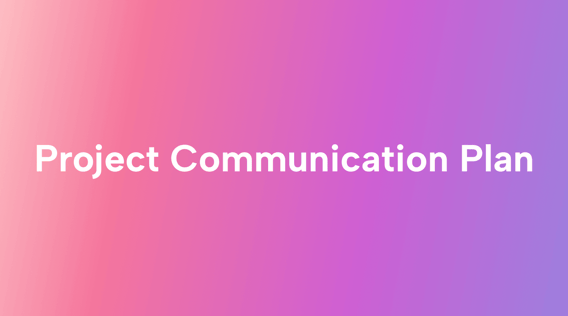Trying to manage a project team can feel like trying to herd cats. Despite your best efforts, team members often move independently in different directions.
Without a clear communication framework, you’ve got your work cut out for you. With different software platforms and communication protocols across teams, chaos is inevitable.
But it doesn’t have to be that way. A clear project communication plan can help you keep everyone on the same page. It outlines who needs to know what, where, and how it should be communicated.
What is a project communication plan?
A project communication plan is an overview of how you’ll communicate project details and progress updates to key stakeholders.
Here’s the gist of what a well-crafted project communication plan covers:
- Your planned project status reports and status meetings.
- Who needs to know what — from project managers and clients to the entire team.
- Frequency — how often you’ll hold meetings or send specific update reports to stakeholders.
- Channel — where your project teams will communicate and which channels you’ll use to update stakeholders.
But it can be hard to conceptualize what this should look like in a finished plan. So here’s an example of a completed communication plan:
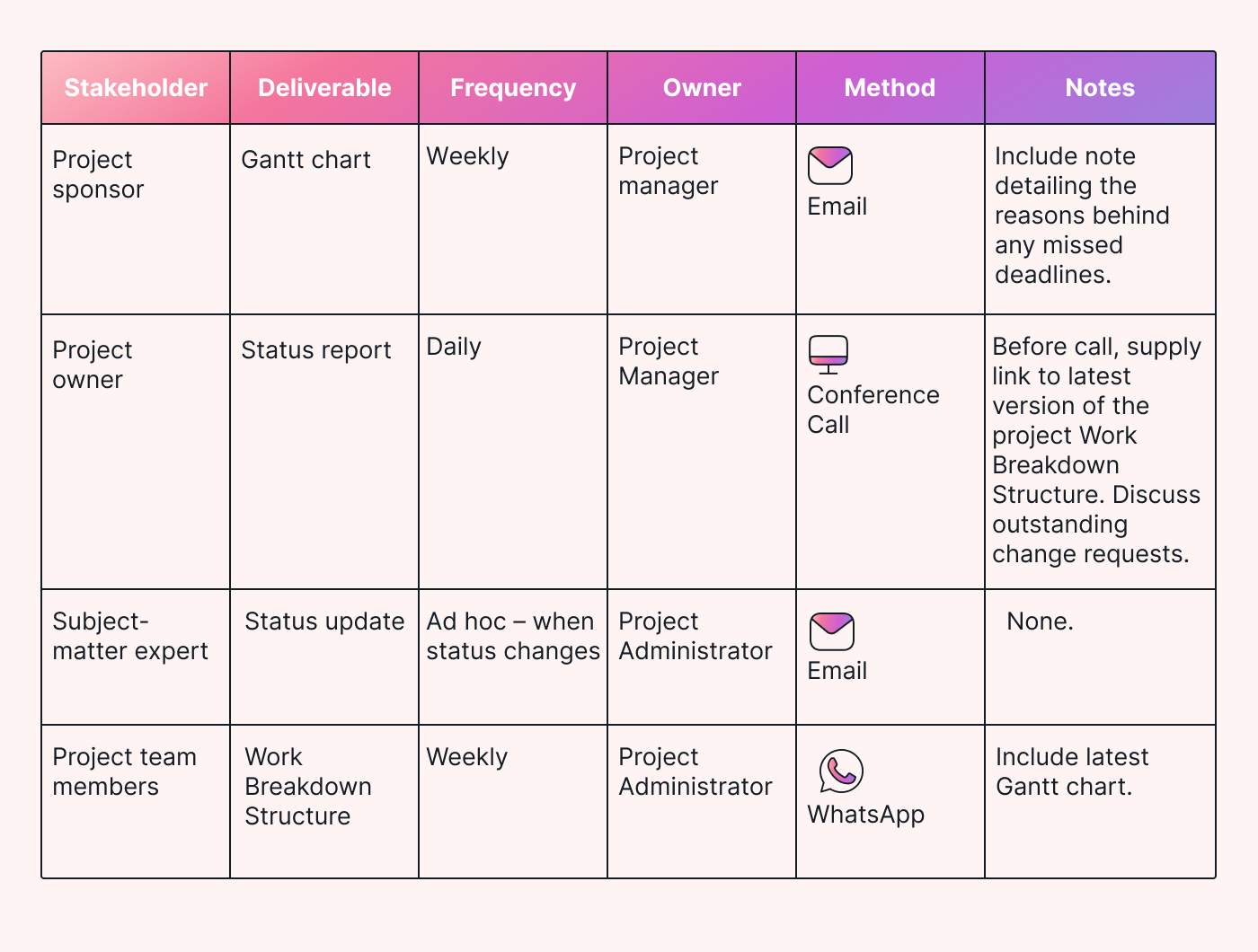 |
The plan specifies stakeholders, the communication channel, the deliverable (report or meeting), its owner, and frequency (when).
You don’t have to format it this way, but this example showcases the minimum requirements for your plan.
By clarifying all of this before the project begins, you significantly reduce the risk of silos and miscommunication.
Why you need a project communication plan
A project team can’t work effectively without good communication between managers, clients, the owner/CEO, and other key stakeholders. As project goals, scope, and requirements change, they need active guidance to help them stay on the right track.
That much is obvious. Yet, bad communication is still a prevalent issue, even for experienced project managers.
In a 2021 survey by the Project Management Institute, 28% of companies said poor communication was a key cause of project failures.
There are many reasons for this:
- Poorly informed managers or business owners can make poor top-down project decisions. For example, bad status reports can misrepresent project progress.
- Teams across locations can work in completely different directions. If they have a different impression of the latest priorities, this will affect what they work on.
- If a client’s needs change and your project team doesn't know this, they can waste 100s of working hours developing unnecessary features.
- With no clear responsibilities or schedule, frequent update requests can disrupt key members of the project team. You want them to work on the project, not talk about it.
Plus, with the advent of the internet, there’s an almost unlimited number of potential communication channels. Not just email and Slack, but every SaaS app is a potential channel (and a potential silo).
But, and this is important, all of these channels can add a new level of complexity to project communication. To play out this risk, you can use the project communication channel formula to calculate the number of channels you could end up with.
A clear communication plan helps you focus on the right channels.
What are the benefits of a good communication plan?
A good project management communication plan makes your project teams more cohesive and helps make sure everyone is on the same page.
 |
Here’s a quick summary of the top benefits:
- It helps you set clear expectations with the team and stakeholders. That helps streamline the project execution process, as everyone knows their role and how to reach out.
- It helps your team adapt to changing requirements and priorities. Effective communication is necessary for a functioning change management process.
- It helps multiple teams stay on the same page. Don’t let project teams turn into islands.
- It improves overall project success rates. With all the teams, managers, clients, and other stakeholders on the same page, the project is much more likely to succeed.
Laying the right foundation for not just project team communication but also communication with your project’s stakeholders is crucial.
How to create a project communication plan that works
There are five critical factors in any effective communication plan. Your plan must:
- Lay out who‘s in each communication channel.
- State what the message is.
- Determine when to communicate.
- Identify where to get the information.
- Specify how to distribute it.
Some project managers call these factors the four Ws and an H: who, what, when, where, and how.
Follow the steps below to figure out your who, what, when, where, and how.
Figure out who should be involved
The first step in preparing any project communication plan is to perform a stakeholder analysis. It helps you figure out who you need to update about different parts of the project. For example, an end client (project sponsor) would want to know the progress on the next version or prototype.
In project management terms, there are a wide variety of project stakeholders:
- Project sponsor: typically a client that's paying for the project.
- Project owner: the manager, owner, or executive ultimately responsible for the project's outcome.
- Project manager: the person who manages the project team and process.
- Subject matter experts: team members with technical expertise relevant to the project.
- Other project team members: engineers, salespeople, developers, or other employees involved in making the project happen.
If you have a RACI chart, much of the (who) information is at your fingertips.
Decide what to use to update the team
The next step is to figure out what deliverables you’ll use to update your project stakeholders.
You could, for example, update the work breakdown structure (WBS), share change requests, and update the project charter.
A Gantt chart is another common progress indicator for projects — a visual breakdown of dependent tasks. It visualizes the project timeline, including start dates, duration, and end dates for each task. You can also color-code tasks based on stage, priority, or task status.
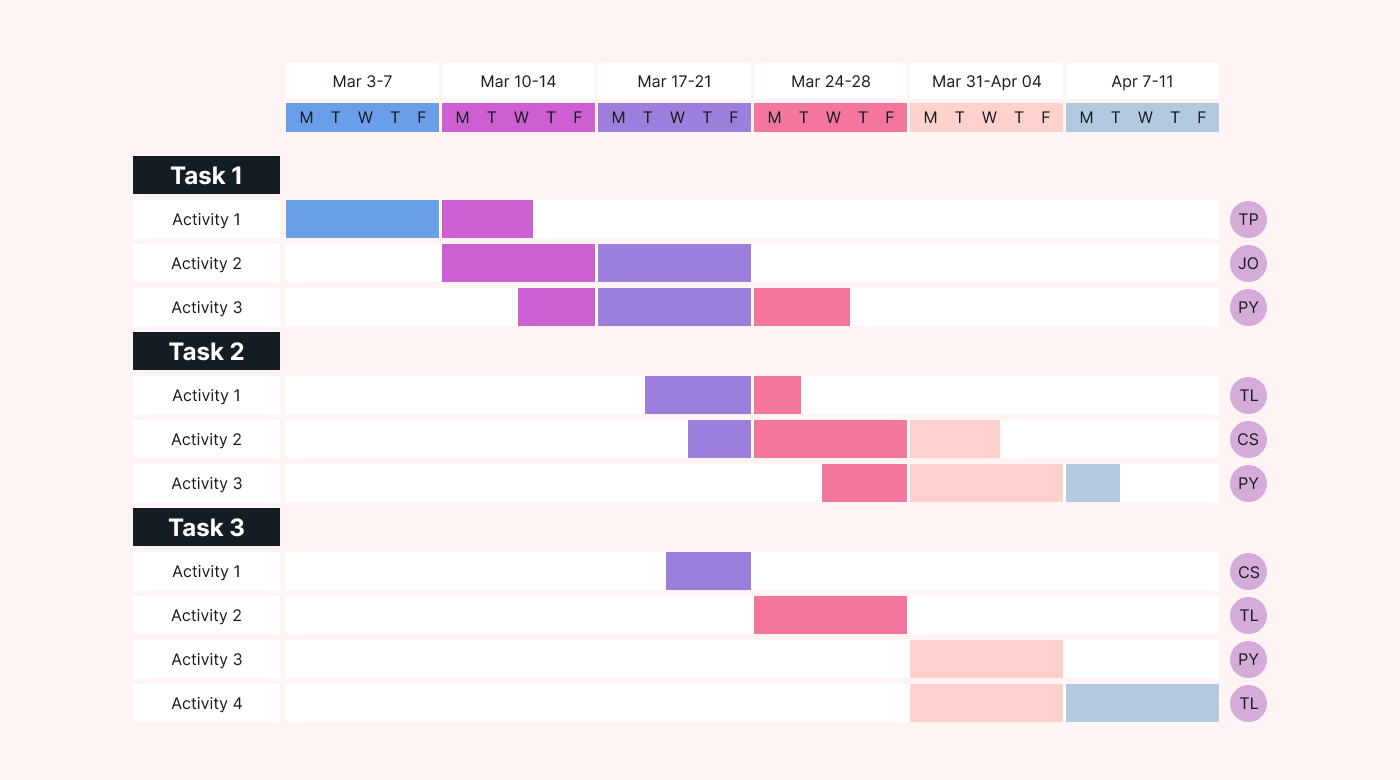 |
A Kanban board is a simple, visual method to keep team members updated on project progress. Since tasks move through clear stages in real time, it's easy for employees and stakeholders to see the status of dependent tasks.
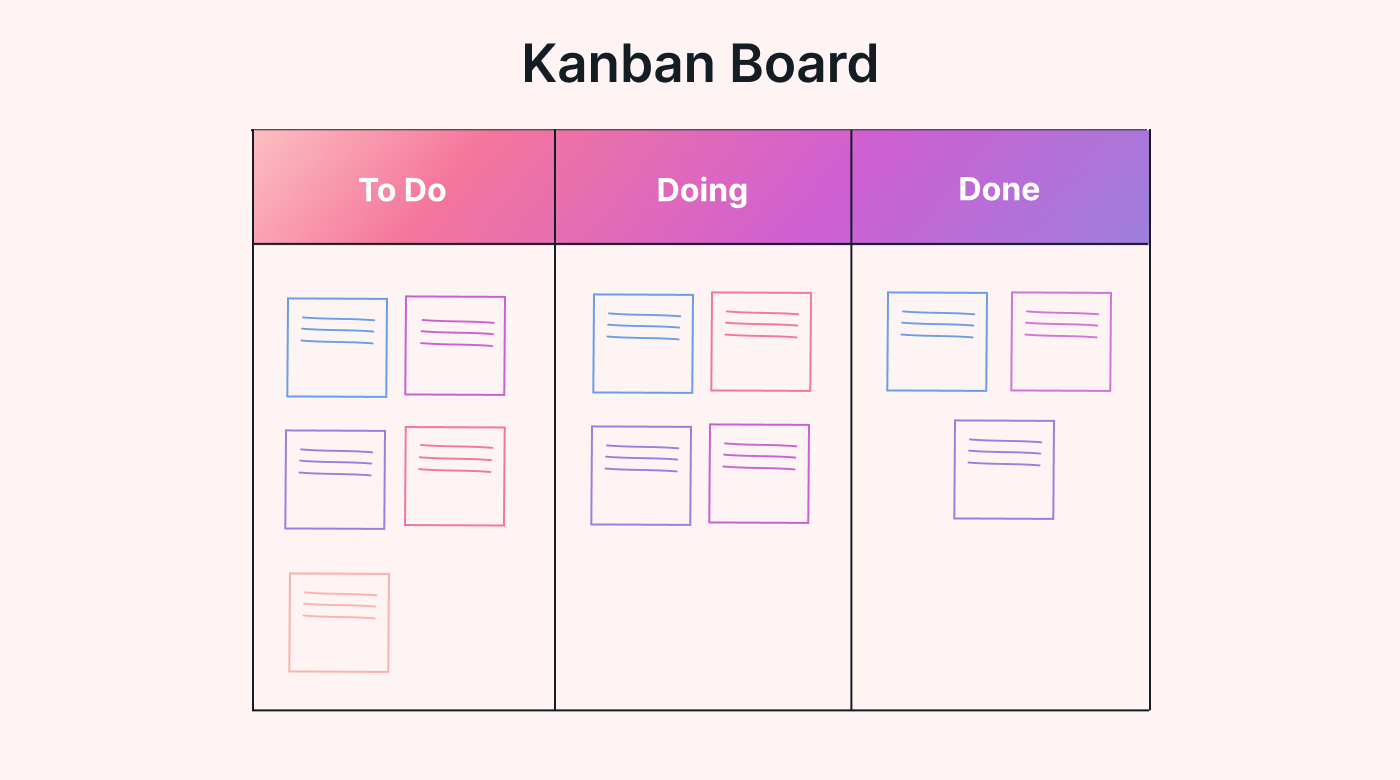 |
Choose the communication methods (where)
There are many different types of communication channels and approaches. In-person meetings, calls, email, Slack, a project management app, you have a lot of options here.
What you choose to use depends on your team’s size, location, and project management method.
For example, in Agile, meetings are a primary channel for status updates. There are plenty of Agile ceremonies — different types of meetings — from quick status update meetings to meetings that decide the future direction of the project.
Set the frequency of communication (when)
There's no ideal communication frequency across report types and stakeholders. You don't want to bombard the business owner or executives with multiple daily updates. You also don't want to only update project team members once a quarter on important milestones.
The key is to identify the right frequency for each report type and each stakeholder.
How often you should meet depends on the scope of the report, the channel, and stakeholder preference. For some rules of thumb, you'd probably update a project sponsor weekly or monthly and the members of the project team daily. But there are no hard-and-fast rules here.
The best way forward is to figure out what your stakeholders prefer — communicate! Ask them how often they want updates. And figure out the right balance between the team and managers.
Manage the process
The final piece is managing the execution of the plan. Here you need to figure out who owns what deliverables and put a system in place to ensure the communication happens routinely.
For example, you can schedule weekly meetings with stakeholders and the project manager where they break down the process. And you can set up automated reminders in your project management solution to stay on pace.
4 best practices for making the most of your project communication management plan
Unfortunately, creating an effective project communication strategy (and plan) isn’t as easy as knowing the building blocks and filling out a checklist or table. You need to create a tailor-made system and roadmap that helps your team and stakeholders communicate effectively.
To get it right, follow these four best practices.
1. Start with a clear set of objectives
To help the process go smoothly, you need to highlight a logical set of objectives to act as the north star.
For example:
- Effectively communicate the timelines, requirements, staffing needs, and project budget to all stakeholders.
- Efficiently collect inputs, feedback, decisions, and approvals from many different project stakeholders.
- Build a reliable system for distributing accurate and transparent information to key stakeholders. It should keep them informed and instill confidence in the progress of project deliverables.
Then, the process of creating your communication plan should look something like this:
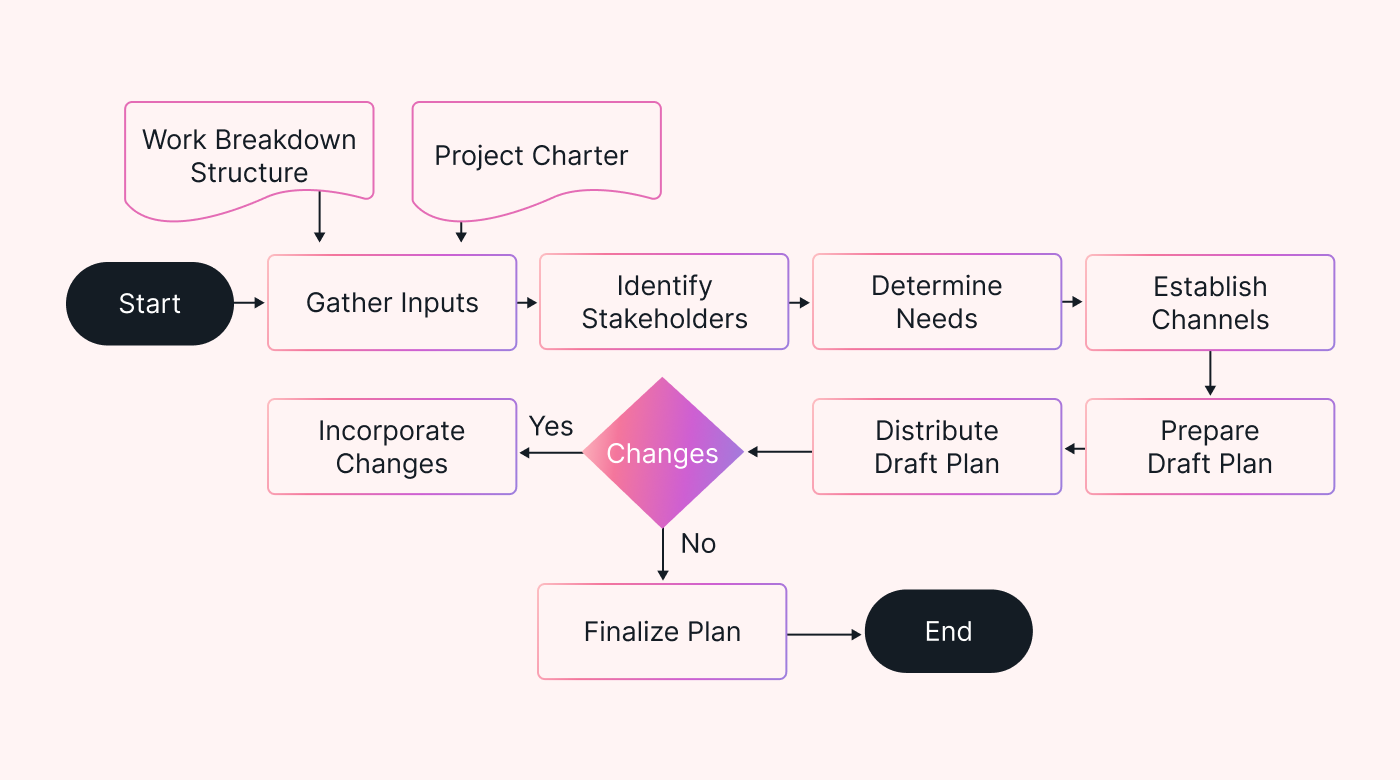 |
2. Build feedback loops into the process
Project communication must be a two-way street. It’s not enough to send project updates and try to “keep everyone in the loop.” Good project managers create a system that lets team members and other stakeholders provide feedback.
Getting feedback early and often is how you avoid project management disasters — blown budgets, missed deadlines, etc. You don’t want to rush around putting out fires in crisis management mode. Instead, slowly adapt to changing requirements — as a team — to guarantee project success.
That’s what an effective communication plan does. It stops your project from descending into chaos for no reason. It keeps all stakeholders up-to-date and keeps the team in line with their changing needs as well.
3. Use automation to ensure communication happens as planned
Working on projects across locations used to be a nightmare of phone calls and emails. Constant conference calls, phone checkups, status update emails, you name it.
Thanks to modern cloud-based project management solutions, you can automate a lot of this.
For example, do you really need to call staff or meet daily if you have a real-time digital Kanban board? Since it shows progress on priority tasks, staff can easily check how this would impact their tasks.
You can even set up automated notifications to managers when tasks or deliverables are overdue.
4. Adapt your communication plan as circumstances change
If you want to succeed, your project plans can’t be carved in stone. As a seasoned manager, you know this already.
But, when it comes to auxiliary documents like a project communication plan, many companies try to “set it and forget it.”
To get meaningful results, you need to treat it as a living, evolving document. Take your team’s feedback to heart and revise and update it when needed.
Use automated scheduling to keep your project team on track with Motion
It's 2023. You no longer have to do every project status update manually.
You don't have to manually schedule meetings (or, worse, call everyone on the team individually).
There's an easier way to do things.
Motion's shared task calendar and Kanban views mean that everyone knows the state of the project in real time.
But (you might think to yourself) any cloud-based project management tool could do that.
What sets Motion apart is our AI-powered automated scheduling, which automatically schedules tasks based on deadlines, priority, and categories. You can even set recurring weekly meetings that the scheduling algorithm will work around.
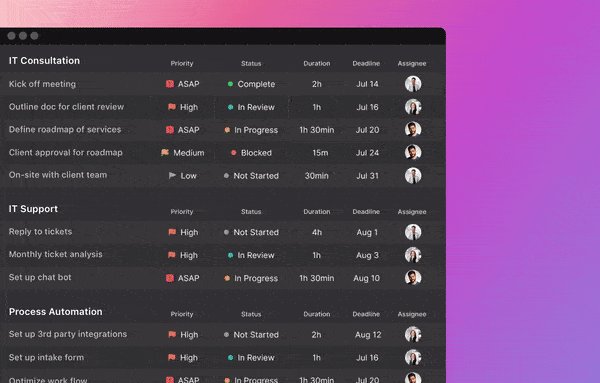 |
Plus, setting up last-minute meetings and calls with our booking system is much easier. It'll automatically feature available slots based on your schedule and rearrange flexible tasks (like writing) if necessary.
As a business owner or manager, you can spend less time on meaningless communication. You don't need to go back and forth about when someone's free; you can focus your energy on what matters.
Sign up for a free trial today to see how Motion can help your team collaborate more efficiently with less superfluous communication.

